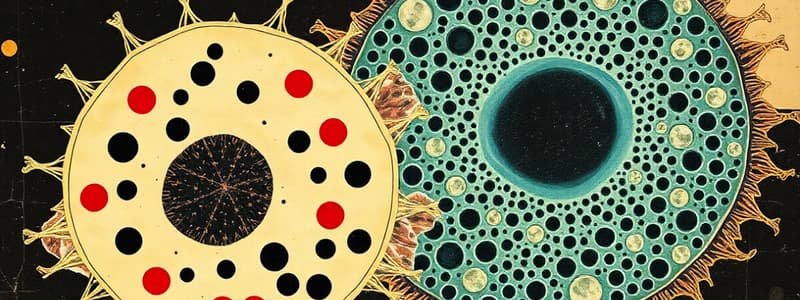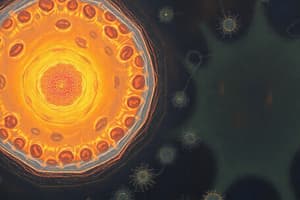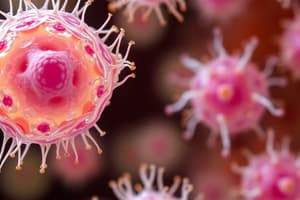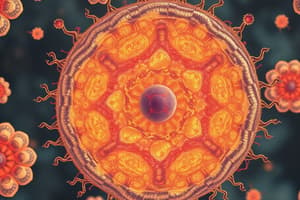Podcast
Questions and Answers
Which of the following is a key distinction between prokaryotic and eukaryotic cells?
Which of the following is a key distinction between prokaryotic and eukaryotic cells?
- Eukaryotic cells lack a plasma membrane, while prokaryotic cells have one.
- Eukaryotic cells have a nucleus, while prokaryotic cells do not. (correct)
- Prokaryotic cells are generally larger than eukaryotic cells.
- Prokaryotic cells contain DNA, while eukaryotic cells do not.
If a cell were unable to produce new ribosomes, which of the following processes would be most directly affected?
If a cell were unable to produce new ribosomes, which of the following processes would be most directly affected?
- DNA replication
- Cellular respiration
- Protein synthesis (correct)
- Lipid synthesis
Which organelle is primarily responsible for modifying and packaging proteins and lipids for secretion from the cell?
Which organelle is primarily responsible for modifying and packaging proteins and lipids for secretion from the cell?
- Mitochondrion
- Lysosome
- Endoplasmic reticulum (ER)
- Golgi apparatus (correct)
A plant cell is placed in a hypertonic solution. What is the most likely immediate effect on the cell?
A plant cell is placed in a hypertonic solution. What is the most likely immediate effect on the cell?
Which of the following structures is NOT found in animal cells?
Which of the following structures is NOT found in animal cells?
If a cell is unable to perform proper apoptosis, which of the following scenarios is most likely to occur?
If a cell is unable to perform proper apoptosis, which of the following scenarios is most likely to occur?
Which of the following best describes the function of the plasma membrane?
Which of the following best describes the function of the plasma membrane?
How is the rough endoplasmic reticulum (RER) different from the smooth endoplasmic reticulum (SER)?
How is the rough endoplasmic reticulum (RER) different from the smooth endoplasmic reticulum (SER)?
Which organelle is responsible for generating ATP through cellular respiration?
Which organelle is responsible for generating ATP through cellular respiration?
What is the primary function of chloroplasts in plant cells?
What is the primary function of chloroplasts in plant cells?
Flashcards
Cell
Cell
The basic structural and functional unit of all known living organisms; the smallest unit of an organism considered alive.
Plasma Membrane
Plasma Membrane
A selective barrier enclosing the cell, regulating the passage of substances in and out; composed of a phospholipid bilayer with embedded proteins.
Cytoplasm
Cytoplasm
The jelly-like substance within the cell, between the plasma membrane and the nucleus, containing cytosol and organelles; site of many metabolic reactions.
Nucleus
Nucleus
Signup and view all the flashcards
Mitochondria
Mitochondria
Signup and view all the flashcards
Endoplasmic Reticulum (ER)
Endoplasmic Reticulum (ER)
Signup and view all the flashcards
Golgi Apparatus
Golgi Apparatus
Signup and view all the flashcards
Lysosomes
Lysosomes
Signup and view all the flashcards
Ribosomes
Ribosomes
Signup and view all the flashcards
Cell Wall
Cell Wall
Signup and view all the flashcards
Study Notes
- The cell constitutes the basic structural and functional unit in all known living organisms.
- It represents the smallest unit of an organism considered alive.
- Cells can independently execute all essential life functions.
- Cell biology is the study of cells.
Cell Structure
- A plasma membrane encloses all cells, separating the cell's interior from the external environment.
- Cells contain cytoplasm, the jelly-like substance filling the cell.
- Cells contain DNA as their genetic material.
Types of Cells
- The two primary cell types are prokaryotic and eukaryotic.
Prokaryotic Cells
- Prokaryotic cells are simpler and generally smaller than eukaryotic cells.
- Nucleus and other membrane-bound organelles are absent in prokaryotic cells.
- Prokaryotic cells have DNA located in the cytoplasm within a region termed the nucleoid.
- Bacteria and Archaea exemplify organisms composed of prokaryotic cells.
Eukaryotic Cells
- Eukaryotic cells are more complex and generally larger than prokaryotic cells.
- Eukaryotic cells possess a nucleus housing the cell's DNA.
- Membrane-bound organelles, such as mitochondria, endoplasmic reticulum, and Golgi apparatus, are present in eukaryotic cells.
- Plants, animals, fungi, and protists are examples of organisms that have eukaryotic cells.
Cell Components and Their Functions
- Key components are the plasma membrane, cytoplasm, nucleus, and various organelles.
Plasma Membrane
- The plasma membrane acts as a selective barrier, regulating substance passage into and out of the cell.
- Its composition includes a phospholipid bilayer with embedded proteins.
- Cell signaling, transport, and maintenance of cell shape are among its functions.
Cytoplasm
- The cytoplasm occupies the region between the plasma membrane and the nucleus.
- Cytosol, a jelly-like substance, and organelles constitute the cytoplasm.
- Many metabolic reactions occur in the cytoplasm.
Nucleus
- The nucleus houses the cell's DNA and governs cell activities.
- A double membrane with pores, known as the nuclear envelope, surrounds it.
- The nucleolus, involved in ribosome production, resides within the nucleus.
Mitochondria
- Mitochondria serve as the cell's powerhouses, producing ATP via cellular respiration.
- Their structure includes a double membrane, with the inner membrane folded into cristae.
- Mitochondria possess their own DNA and ribosomes.
Endoplasmic Reticulum (ER)
- The ER is an extensive membrane network participating in protein and lipid synthesis.
- Two ER types exist: rough ER (with ribosomes) and smooth ER (without ribosomes).
- Protein synthesis and modification are functions of the rough ER, while lipid synthesis and detoxification are functions of the smooth ER.
Golgi Apparatus
- The Golgi apparatus processes and packages proteins and lipids.
- Flattened membranous sacs called cisternae comprise it.
- The Golgi apparatus is responsible for modifying, sorting, and packaging proteins and lipids for secretion or delivery to other organelles.
Lysosomes
- Lysosomes are organelles that contain enzymes for breaking down cellular waste and debris.
- They digest old or damaged organelles, along with engulfed viruses and bacteria.
- Programmed cell death (apoptosis) involves lysosomes.
Ribosomes
- Protein synthesis is the function of ribosomes.
- They are present in the cytoplasm and on the rough ER.
- Ribosomes translate mRNA into proteins.
Cell Wall
- Plant cells feature a cell wall, a rigid outer layer providing support and protection.
- Cellulose is the primary component of the cell wall.
- Maintaining cell shape and preventing excessive water uptake are functions of the cell wall.
Chloroplasts
- Plant cells contain chloroplasts, organelles that conduct photosynthesis.
- Chlorophyll, a pigment capturing light energy, is present in chloroplasts.
- Light energy is converted into chemical energy (glucose) by chloroplasts.
Vacuoles
- Vacuoles are large vesicles storing water, nutrients, and waste products.
- Plant cells have a large central vacuole that maintains cell turgor pressure.
- Cell growth, storage, and waste disposal involve vacuoles.
Cell Functions
- Cells perform life-sustaining functions, including:
- Metabolism: Cells execute chemical reactions for energy acquisition and molecule synthesis.
- Growth: Cells increase in size and number through cell division.
- Reproduction: Cells create new cells through cell division.
- Response: Cells react to stimuli from their surroundings.
- Homeostasis: Cells maintain a stable internal environment.
Cell Communication
- Cells communicate via chemical signals.
- Signals can be transmitted by direct contact, local signaling, or long-distance signaling.
- Coordinating cell activities and maintaining homeostasis depend on cell communication.
Cell Division
- The process by which cells produce new cells is cell division.
- Mitosis and meiosis are the two main types of cell division.
- Mitosis yields two identical daughter cells for growth and repair.
- Meiosis yields four genetically different daughter cells for sexual reproduction.
Studying That Suits You
Use AI to generate personalized quizzes and flashcards to suit your learning preferences.




